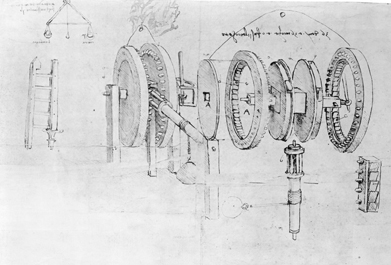Section 3
| Site: | MoodleHUB.ca 🍁 |
| Course: | Math 20-3 SS |
| Book: | Section 3 |
| Printed by: | Guest user |
| Date: | Tuesday, 2 December 2025, 7:05 AM |
Description
Created by IMSreader
1. Section 3
Section 3: Exploding Objects
Section 3 Introduction

© Rpsycho/iStockphoto
Interested in carpentry? Want to build that perfect wilderness cabin? The Internet has many web pages that feature detailed plans. Most sites include exploded views—three-dimensional drawings that illustrate construction down to the smallest detail. Exploded views complement written instructions and are essential in understanding designs, not only for home construction but also for assembling modular furniture, repairing your bicycle, or ordering parts for your vehicle.
In this section you will explore the many applications of exploded views. You will also interpret and sketch exploded-view diagrams.
1.1. Lesson 1
Section 3: Exploding Objects
Lesson 1: Exploded Views and the Objects They Represent
Focus

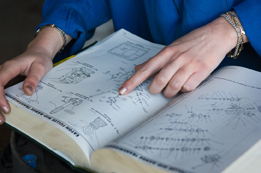
both: Photos.com/Thinkstock
Macey is a second-year parts technician apprentice. She is working in a used farm equipment and truck warehouse. She is responsible for reading manuals and parts books on various tractors, combines, balers, trucks, and other vehicles used on acreages and farms. When a customer phones in, Macey needs to be able to locate the appropriate manual or parts book, locate the part in the book, look the part up on her computer, inform the customer whether the warehouse has or can get the part, and determine what the part will cost.
Macey remembers feeling overwhelmed with all the different engines and their complex assemblies when she started her three-year apprenticeship. Now Macey finds it an adventure to locate a part she has never seen before in exploded-view diagrams.
Lesson Questions
In this lesson you will investigate the following questions:
- What are the characteristics of exploded views?
- How do exploded views help describe objects?
Assessment
Your assessment for this lesson may include a combination of the following:
- course folder submissions from the Try This and Share sections of the lesson
- your contribution to Mathematics 20-3: Glossary Terms
- Lesson 1 Assignment (Save a copy of your lesson assignment to your course folder now.)
Materials and Equipment
- paper and pencil
Time
This lesson has been designed to take 150 minutes; however, it may take more or less time depending on how well you are able to understand the lesson concepts. It is important that you progress at your own pace based on your own learning needs.
1.2. Discover
Section 3: Exploding Objects
Discover
Try This 1
Play with Exploded View Interactive, and then answer the questions that follow.
- Explain how you decided to order the parts in Exploded View Interactive. How did you decide what was first and what was last?
- What do the double arrows represent?
![]() Save your responses to your course folder.
Save your responses to your course folder.
1.3. Explore
Section 3: Exploding Objects
Explore
In Discover you built exploded views in Exploded View Interactive. You saw how these views show the order and relationship between the different parts in an object.
Some important characteristics of an exploded view are as follows:
- All parts must be in the order of how they would be assembled or disassembled.
- Parts will be in line with where they are to be placed on the object.
- Dotted lines may be included to show the direction of assembly.
Try This 2
The following diagram is an exploded view of a coffee table.
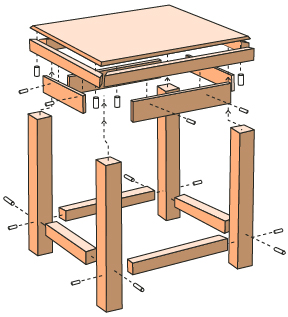
This is the exploded view of a rocket.
![]()
Dorling Kindersley RF/Thinkstock
- Why is the term exploded view appropriate for these types of diagrams?
- If you were assembling the coffee table, what pieces would you put together first?
- Would you prefer an exploded view or a written description when assembling an object? Why?
- Why are there spaces between the components in the rocket diagram?
- Search the Internet and find businesses and occupations that would use exploded-view diagrams.
![]() Save your responses in your course folder.
Save your responses in your course folder.
Share 1
Discuss your answers to Try This 2 with a partner or with a group of people.
- Compare the differences and similarities between your answers.
- Combine your lists for question 5.
![]() Save your combined list and any changes you made to your Try This 2 answers to your course folder.
Save your combined list and any changes you made to your Try This 2 answers to your course folder.
If required, save a summary of your discussion to your course folder.
1.4. Explore 2
Section 3: Exploding Objects

Comstock/Thinkstock
As you saw in Try This 2, exploded views are very important for many trades. Imagine that you work as a mechanic in your community. You are about to repair an alternator. Do you have the skills to follow an exploded view? Can you reassemble the alternator? Work through Alternator Assembly to find out.
Try This 3
Watch Alternator Assembly again. Record step by step what is removed when the alternator is taken apart. Then reassemble the alternator component by component. What do you notice as you try to reassemble the alternator?
![]() Save your responses to your course folder.
Save your responses to your course folder.
Share 2
Share and discuss your responses to the question in Try This 3 with a classmate or in a group.
![]() If required, save a copy of your discussion in your course folder.
If required, save a copy of your discussion in your course folder.
In the next part of the lesson, you will identify objects from their exploded views.
1.5. Explore 3
Section 3: Exploding Objects
Example
What common object does the exploded view shown represent? Sketch the object.
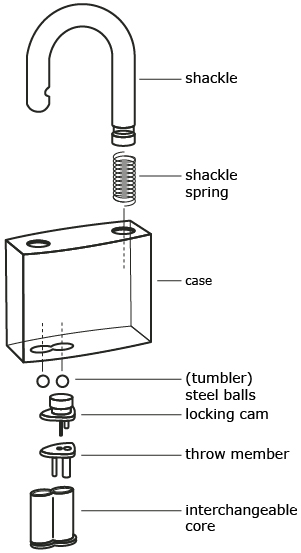
Solution
The exploded view is of a padlock.
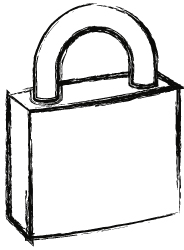
In the example, the parts are identified by name. This is helpful when the written instructions refer to parts in repair manuals, assembly diagrams, and parts catalogues.
Now, it’s your turn.
Self-Check 1
For questions 1 to 3, identify each object from its exploded view. Sketch the object.
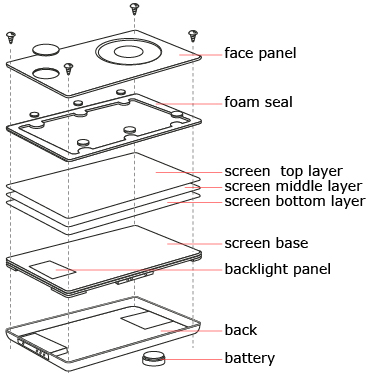
Answer
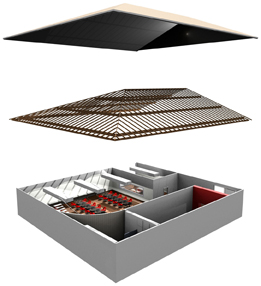
© Media4dltd/Dreamstime
Answer
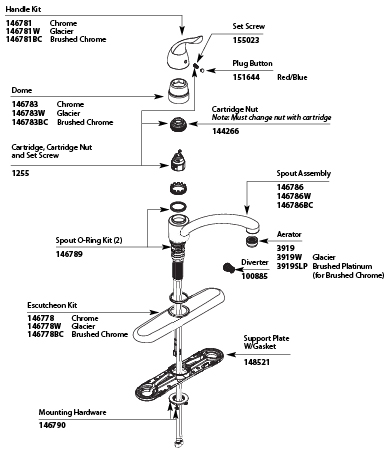
CREDIT: Printed with permission of Moen Inc.
Answer
- Watch “The NASA/ESA Hubble Space Telescope, assembled and in an exploded view.” Do you think this exploded diagram is complete? Why or why not?

ESA/Hubble (M. Kornmesser & L. L. Christensen)
Answer
It is now time to add new math terms to Mathematics 20-3: Glossary Terms.
In this lesson the new term you will add is
- exploded view
1.6. Connect
Section 3: Exploding Objects
Connect
Going Beyond
In this lesson you explored technical drawings of inanimate objects. Did you know that exploded views are one way of teaching and illustrating anatomy? The following exploded view is of the human skull. Using the Internet, you can discover a wealth of information available in this area of study and other areas that use exploded views.
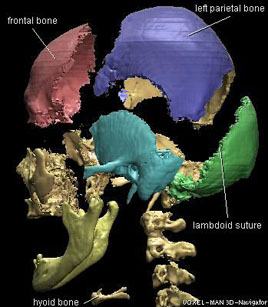
Used with permission from Voxel-Man, University Medical Center Hamburg-Eppendorf, www.voxel-man.de.
Lesson 1 Assignment
Your lesson assignment contains some problems for you to solve using the knowledge gained during the lesson. Now you will have the chance to apply the concepts and strategies that you have learned to a new situation. Please show work to support your answers.
Open the Lesson 1 Assignment that you saved to your course folder and complete the questions.
1.7. Lesson 1 Summary
Section 3: Exploding Objects
Exploded views have been used by artists and inventors for centuries. The exploded view shown is one of a reciprocating-motion machine sketched by Leonardo da Vinci (1452–1519). This view can help people understand how the invention was supposed to work. Search the Internet if you would like to learn more about this image.
In this lesson you explored exploded-view diagrams and their characteristics. Exploded views are used in technical drawings from carpentry to mechanics to plumbing to anatomy!
1.8. Lesson 2
Section 3: Exploding Objects
Lesson 2: Drawing an Exploded-View Diagram
Focus

Have you made a smoothie in a blender? If you have used a blender, you have had to take the container apart to wash up. Once dry, the container can be reassembled for storage. Look at the exploded view of the blender in the diagram. Is your blender similar? Perhaps you could have drawn a similar diagram. In this lesson you will explore the basics of drawing an exploded view.
Lesson Questions
In this lesson you will investigate the following questions:
- How are exploded-view diagrams drawn?
- How important is scale in exploded-view diagrams?
Assessment
Your assessment for this lesson may include a combination of the following:
- course folder submissions from the Try This and Share sections of this lesson
- your contribution to Mathematics 20-3: Glossary Terms
- Lesson 2 Assignment (Save a copy of your lesson assignment to your course folder now.)
- the Project Connection
Materials and Equipment
- pens
- pencils
- geometry set
- ruler
Time
This lesson has been designed to take 150 minutes; however, it may take more or less time depending on how well you are able to understand the lesson concepts. It is important that you progress at your own pace based on your own learning needs.
1.9. Discover
Section 3: Exploding Objects
Discover
Birdhouses are very common in a backyard landscape, but assembling one can get tricky. Assembly diagrams can be very helpful.
Try This 1
Print a copy of Birdhouse Exploded View.
Follow the instructions in Birdhouse Interactive, and then answer the questions that follow.
- What did you notice about the dimensions of the exploded view in comparison to the dimensions in Birdhouse Interactive? How does that help you determine the scale factor?
- What could happen if one dimension on the exploded view was not accurate with respect to the scale factor?
Share 1
Share your responses to the questions in Try This 1 with a classmate or in a group. Next, create a statement together that describes the importance of scale factor when drawing an exploded view of a three-dimensional object.
![]() If required, save a copy of your discussion in your course folder.
If required, save a copy of your discussion in your course folder.
1.10. Explore
Section 3: Exploding Objects
Explore
So far in Module 5 you have explored drawing three-dimensional objects using orthographic views, isometric views, and one-point perspectives. In this lesson you will explore exploded-view drawings and, whenever possible, drawing parts using the same scale factor relative to the original object.
Watch “Technical Drawing Applications” to see how exploded-view drawings and scale drawings are used in a variety of applications.
To see other applications of exploded-view drawings, open your favourite search engine and use the keywords “tech student” and “exploded drawings - 4.”
One of the features of exploded views is annotations. Annotations are the labels that identify component parts in exploded views.
Look back at the two examples provided in the animations. Do you notice how the “wheels” and “eccentric cams” are labelled in the exploded view of the toy duck? The parts of the compass are all numbered. How could numbering parts be helpful?
Try This 2
Xenia is interested in pursuing a career in design. She took two pictures: one of a flashlight assembled and one of the flashlight taken apart. Her photograph of the components of the flashlight shows the parts in the order they were removed. She used her photographs to draw an annotated exploded view of the flashlight.
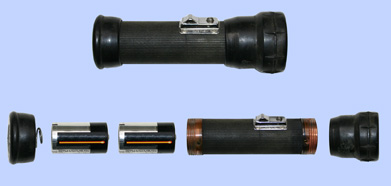
- Print a copy or copy and paste Xenia's Pictures into a drawing or word-processing program. Label the picture to make the picture annotated. Draw in dashed lines to indicate the method of assembly.

- When Xenia drew her exploded view, she was careful to maintain the same scale factor for each component that she drew. She drew each dry cell (battery) one-third the length of each actual dry cell. What scale factor should she use to draw the bulb?


- What feature of exploded views shows that the components are assembled in the order in which they are drawn?
![]() Save your responses to your course folder.
Save your responses to your course folder.
1.11. Explore 2
Section 3: Exploding Objects
Example
Carmen photographed an adjustable wrench (spanner). The parts of the adjustable wrench in the second photograph are, from top to bottom, handle with fixed jaw, knurl, pin, and adjustable jaw.
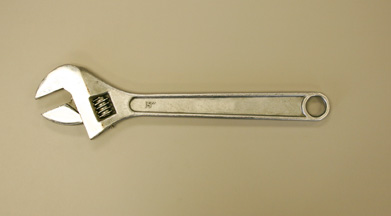
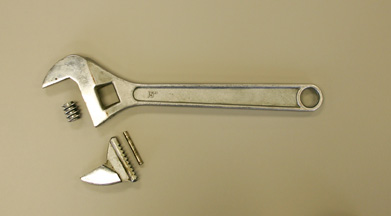
- Make a sketch of the wrench, adding labels and dashed lines to give an annotated exploded view.
- If the length of the actual wrench is 10 in, what is the approximate scale of the picture?
Solution

- If the length of the handle and fixed jaw in the exploded view were 5 in—one-half that of the actual wrench—the scale would be 1:2.
1.12. Explore 3
Section 3: Exploding Objects
Now it is time to practise your skills.
Self-Check 1
- Wilma bought her toddler a wooden puzzle at a craft show. Sketch an exploded view of the puzzle.
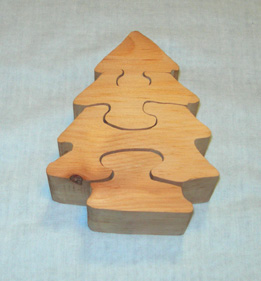
Answer
-
Use the second photo to draw an annotated exploded-view diagram of the adjustable carpenter’s square. The parts shown are the 12-in ruled blade, square head (stock), lock bolt, and nut.
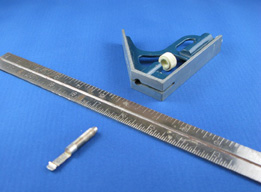
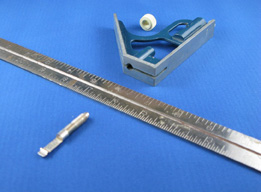
Answer
-
Below is an exploded view showing how to brace two blocks of wood together. The two blocks of wood are identical and, in real life, are each 2 in thick. Print a copy of Wood Blocks Picture.
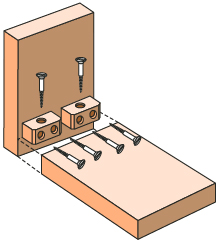
- Using a ruler, measure the dimensions of the base block of wood in the diagram. Answer
- If the actual thickness of the base piece of wood is 2 in, what scale factor was used for the exploded-view diagram? Answer
- Using this scale factor, what would the dimensions of the actual real-life blocks of wood be? Answer
- Using a ruler, measure the dimensions of the base block of wood in the diagram. Answer
It is now time to add new math terms to Mathematics 20-3: Glossary Terms.
In this lesson the new term you will add is
- annotation
1.13. Connect
Section 3: Exploding Objects
Connect
Going Beyond
In this lesson you drew exploded diagrams by hand. However, there are software alternatives. One alternative is Google SketchUp. At the time this lesson was developed, the download for one version of this software was free.
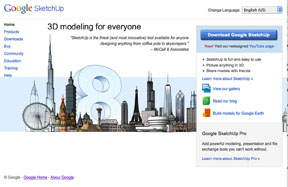
One example of what is possible using Google SketchUp is an exploded view of an “Access Platform.” If you would like a challenge, use Google SketchUp for the three-dimensional tasks you need to complete in the Lesson 2 Assignment and Module 5 Project. To find the software, search for “google sketchup” using your Internet browser.
Project Connection
You have now worked with exploded views and are ready to complete Part 1 of “Complete Your Drawings and Build a Scale Model” of the Module 5 Project from page 247 of the textbook.
At the end of this lesson your entire project should be complete. Self-assess your project using the Module 5 Project Rubric.
Submit your entire Module 5 Project and self-assessment to your teacher.
Lesson 2 Assignment
Your lesson assignment contains some problems for you to solve using the knowledge gained during the lesson. Now you will have the chance to apply the concepts and strategies that you have learned to a new situation. Please show work to support your answers.
Open the Lesson 2 Assignment that you saved to your course folder and complete the questions.
1.14. Lesson 2 Summary
Section 3: Exploding Objects
Lesson 2 Summary
Still and animated exploded views, put together by sophisticated computer-aided design (CAD) software, can be beyond impressive! If you search the Internet, you can find fantastic animations showing exploded views coming together and breaking apart.
For two good animations, do an Internet search using the keywords “awesome engine animation” and “solidworks model of Porsche Carrera GT video.”
The components of an object and the method of assembly are essential elements in an exploded-view diagram. Even more importantly, understanding the size and scale of all the components allows models to be built and tested. In this lesson you drew exploded views to scale for a variety of common objects and you reviewed the features that good exploded-view diagrams include.
1.15. Section 3 Summary
Section 3: Exploding Objects
Section 3 Summary
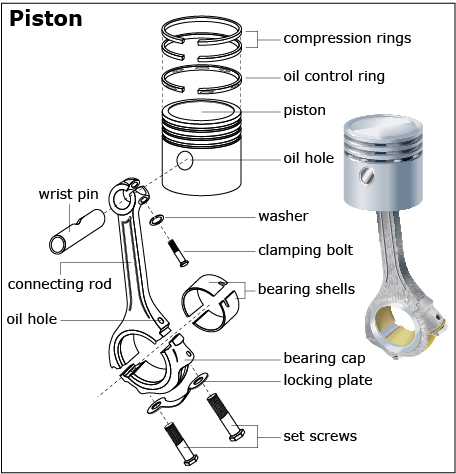
Whether you are an auto buff or a service technician, access to exploded-view diagrams for ordering and assembling vehicle parts is a must. Talk to any mechanic. She or he is certain to tell you how easy it is to forget the order in which components go back together after disassembly!
In this section you explored reading and preparing exploded views. These diagrams have similar characteristics regardless of whether they are prepared by a draftsman, artist, or computer-aided design software.


